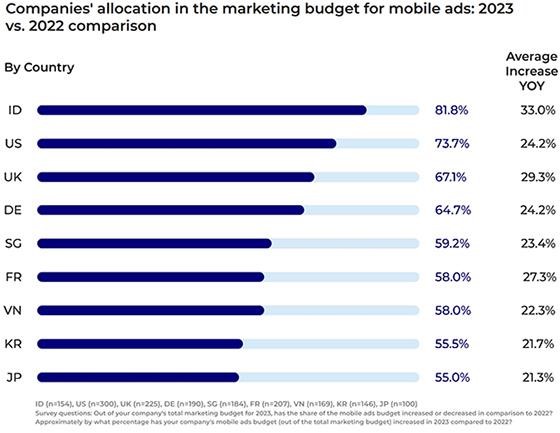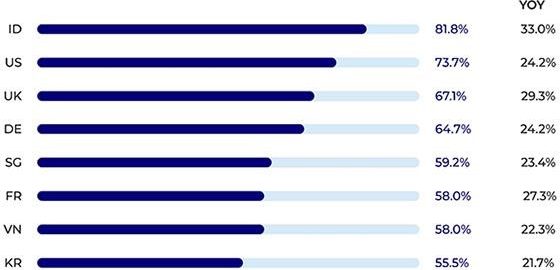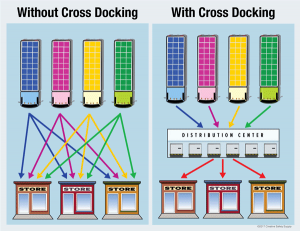The ‘P’ In Performance Is Pronounced ‘Mobile’

One of the most important lessons from challenging economic times in the past is determining the perfect media mix to keep strategies afloat.
Recovery is a difficult process and risk can explode in directions that many marketers cannot begin to imagine, even with progressive technologies like machine learning and artificial intelligence.
Marketers are turning more toward performance mobile app marketing. A study released Tuesday found 64.7% of marketers increased mobile advertising marketing budgets in 2023 to weather a difficult economy, compared with the previous year.
Moloco, a global performance-based demand-side platform supporting companies such as GoPuff and DraftKings, collaborated with Ipsos, an independent research firm, to determine trend patterns related to mobile app marketing. Some 1,675 marketers across nine countries participated. The study, called the Mobile App Performance Marketing Report, was fielded between April 3 and May 1, 2023.
Marketers told Moloco and Ipsos that mobile-ad marketing budgets rose by approximately 25.7% in 2023 compared with the prior year. Performance marketing in 2023 took 45.7% of the mobile advertising budget, while brand marketing took 41.4%, according to the data. And 63.2% of marketers at surveyed companies said they would increase the performance marketing portion of their overall mobile ads budget in 2023.
This growth is noticeable for performance marketing — especially in countries like Indonesia, the U.S., the U.K. — and industries beyond gaming, including ecommerce, IT solutions, business, education, and finance, indicating widespread adoption, according to the data.
The switch to performance in poor economic times isn’t new, but data from this study shows a strong shift “from brand to performance marketing,” said Molly Passanisi, vice president at Moloco. “In times of economic uncertainty, it’s not unusual to see more of a focus on profitability.”
Some 58.2% of marketers cited performance marketing as a more effective media for driving revenue growth than traditional brand marketing, and 55.5% view performance marketing as the key to profitability during times of economic uncertainty.
Machine learning (ML) is the key success factor for global marketers, with 37% of them selecting “advanced ML and artificial intelligence (AI) as the most important from a list of 10 possible technologies.
Other important factors include global reach at 23.1%, and high-quality user acquisition at 18.1%. The role of machine learning is credited with providing real-time, accurate data for decision-making and goal monitoring.
Companies that have raised their performance marketing budget anticipate a subsequent increase in revenue growth and profitability. Driven by the goals of increasing revenue and satisfaction from past campaigns, the ability to measure performance significantly influences higher budget allocation to performance marketing.
Marketers cited several reasons for the increase in performance marketing budgets in 2023 vs. 2022. Some 58.2% expect performance marketing will drive more revenue growth compared with brand marketing, while 56.4% cited being satisfied with the results of performance marketing campaigns last year.
About 55.5% of marketers said they want to invest in increasing profit during macroeconomic headwinds, and 50.9% said performance marketing campaigns are easy to measure return on ad spend. Some 27.3% also expect performance marketing to drive more profitability.
The data also shows that Performance marketing is shifting the landscape in connected television (CTV). With this broader shift toward performance and outcomes-based marketing, advertisers are increasingly shifting their attention toward incremental channels such as CTV.
This year, U.S. CTV ad spend is projected to total $25.09 billion, compared with linear TV with $61.31 billion, according to Insider Intelligenence. With the added data granularity and the ability to target, measure, and report on a one-to-one basis in CTV, the natural outcome is measurable performance and measurable outcomes on the big screen.
This channel, formerly reserved for “top-of-funnel” marketing spend, has proven an opportunity for performance. As the supply of CTV continues to expand, streamers will need to differentiate their offering to advertisers.
During the past half-decade, marketers have poured billions of dollars into CTV with limited outcomes in justifying ROAS, so when it comes to CTV, advertisers will increasingly demand strong and measurable returns on advertising spend, according to the report.
(6)
Report Post





